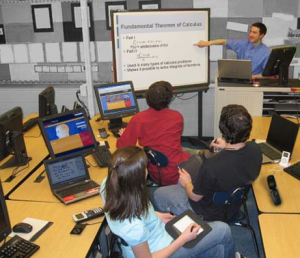My senior year of high school, my AP Calculus classroom was given a grant from the state of Pennsylvania for “technology”. This meant we had a SMART board and twenty laptops (even though there was only nine people in the class). I will admit it was pretty fun to pick out the colors from the SMART board and draw our sine and cosine graphs virtually instead of with chalk, but I never quite understood the forced fifteen minutes a day spent somehow incorporating laptop computers into limits and integrals. I was always uncomfortable with the specific guidelines for allocated time PA put on our classroom in order for us to keep our grant. There was always something that did not sit well with me about the fact that our well-off countryside public high school didn’t really  need the money from the PA Education Department. Surely there were other schools in our state that were in much greater need than ours, and maybe for this reason I felt uncomfortable moving away from traditional pencil and paper and into the new world of technology.
need the money from the PA Education Department. Surely there were other schools in our state that were in much greater need than ours, and maybe for this reason I felt uncomfortable moving away from traditional pencil and paper and into the new world of technology.
The saddest part about this antecdote is that I was in high school just five years ago. The rate at which technology is being integrated into the school system is growing exponentially in recent years. Teachers are using technology in the classroom as a new tool for added learning potential. The use of technology can be seen through such things as SMART boards, laptops, tablets, and online computer assignments. The use of technology is going even further as teachers explore a new teaching technique where their classroom time is spent reviewing hands-on examples, and the students’ homework is to view online videos of the teacher’s lecture. Other uses of technology are spreading constantly. This year, the non-profit I work for Turning the Page started a literacy through photography program, allowing the kids to use photo journaling as a way to inspire their creative and descriptive writing.
A strong positive argument for the use of technology is that it gives students an active role in their learning. A student will have to make decisions about how to generate, locate, display, or explore information. With lecture listening or textbook reading, the student loses their decision making power and becomes less invested in the material. With interactive technology, students set their own goals and can potentially receive immediate evaluation of their work.
There are more specific findings that point to technology based learning as an important component of our country’s future education path. The Department of Education accumulated results from over 1000 empirical studies which found online learning in K-12 as well as at the university level to lead to “modestly better” performance. These findings may be the reason more and more educators are assigning online assignments where students can check their own work and receive feedback to their own specific mistakes.
Additionally, teachers can track students progress much more efficiently. Some statistics claim that after a week of online activity, a certain program can predict with 70% accuracy the likelihood of the student’s failure of the course. While predictions such as these must be considered cautiously, as they could create self-fulfilling prophecies or teacher bias, they can also be seen as an important tool for teachers to track student progress and have empirical data on their students’ strengths and weaknesses.
Proponents of technology in the classroom also point to their cost-saving potential. Financially, a switch from traditional textbooks to e-books could lead to estimated savings of $600 per student annually. Home schooling can now be completed via online sessions, and even in the higher education world virtual credit has become an affordable alternative to ever increasing traditional college courses.
There is no doubt that technology is spreading rapidly, but is it spreading widely? Just five years ago, only a handful of senior classrooms in my school had SMART boards, now they’re entering more and more classrooms at each grade level. In some districts across the country, laptops are being provided to students at an elementary school age. Even though technology might be the preferred new teaching method, is it realistic and accessible for use by all teachers?
Cost-saving strategies through technology (such as ebooks mentioned above) could be a way to close the achievement gap by bringing access to similar quality educational resources to students in every school district, but what about the more expensive tools? As in my case, SMART boards and laptops were provided by state grants, but not all districts across the state received the same technology. When some public schools are still unable to afford appropriate calculators for trigonometry and calculus classes, is it really fair that fourth grade students are allowed to use iPads in their classroom to complete their multiplication problems?
As technology inevitably spreads in our education system, it is our responsibility to make sure its use does not widen the academic achievement gap even further. Without prohibiting technology’s effective use by our wealthier students, how do we make sure the financially disadvantaged do not have to pay the academic price? Potential solutions could be the fair and equitable distribution of technology grants from the state and federal government, the free and abundant access to computers in public libraries, and the increased exposure to technology provided by the non-profit sector (as is the case with Turning the Page’s photography program). Technology in the classroom has a place in our country’s educational future, we just need to make sure that statement is true for every student if we want to shrink the achievement gap and provide an equitable educational system for the entire country.


